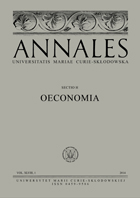Changes in the Capital Structure of Polish Companies During the Last Twenty Years (1997–2017)
Changes in the Capital Structure of Polish Companies During the Last Twenty Years (1997–2017)
Author(s): Jerzy Gajdka, Marek SzymańskiSubject(s): Economy, Business Economy / Management, Financial Markets
Published by: Wydawnictwo Naukowe Uniwersytetu Marii Curie-Sklodowskiej
Keywords: capital structure; debt; corporate finance; pecking order theory; trade-off theory
Summary/Abstract: Theoretical background: The capital structure is one of the most important areas in the modern theory of corporate finance. It has inspired the development of a large number of theoretical approaches, but a universally accepted theory of capital structure has not yet been developed. A common belief holds that companies try to achieve a stable capital structure in the long term; thus, companies that, at a given time, are characterised by a relatively low (or high) level of debt, also probably had the same level in previous periods.Purpose of the article: The main purpose of this paper is to provide answers to two basic questions: 1) How did the aggregate capital structure of the non-financial companies listed on the Warsaw Stock Exchange (WSE) change from 1997 to 2017?; 2) What factors are decisive for the companies’ capital structure and do the current trends in capital structure theory take account of them?Research methods: The research is carried out in two phases. In phase 1, the descriptive statistics method is applied to analyse how the capital structure of WSE-listed companies changed in the years 1997–2017. In phase 2, the capital structure determinants are examined using multiple regression models.Main findings: The capital structure of WSE companies varied significantly in the sample years, and overall, the debt ratios, total, short-, and long-term debt slightly increased. The causes of the changes were the economic environment factors (banking sector assets, government debt, and corporate income tax) and macroeconomic circumstances, along with the companies’ characteristics. Among the latter, the company’s profitability and the share of fixed assets in total assets usually turned out to be statistically significant.
Journal: Annales Universitatis Mariae Curie-Skłodowska, Sectio H Oeconomia
- Issue Year: LIII/2019
- Issue No: 4
- Page Range: 53-68
- Page Count: 16
- Language: English

